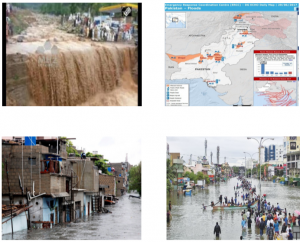Climate change is changing the way we interact with our environments. Climate is the weather conditions prevailing in an area in general or over a long period. The significant climate threats to Pakistan are;
 Climate change is long term alteration of temperature and normal weather patterns in a place. This could refer to a particular place or the planet as a whole. Climate is currently changing throughout the world due to global warming.
Climate change is long term alteration of temperature and normal weather patterns in a place. This could refer to a particular place or the planet as a whole. Climate is currently changing throughout the world due to global warming.
Global warming is increase in planet’s overall temperature. Release of green house gases from industries, vehicles and other modern instruments causes global warming.
Different places have different climate. For example, a desert has dry and arid climate because of very high temperature ranges. Other types like tropical regions are hot and humid which have warm summers and cooler winters. Climate of an area includes;
- Average seasonal temperature
- Rainfall
- Snowfall
- Wind pattern
If we discuss climate change in context of Pakistan, unfortunately the conditions are very alarming. Pakistan is facing with severely changing climate. Pakistan have all four types of seasons. The hottest areas like Jacobabad and the coolest areas like Northern areas are present in Pakistan. So, it’s a difficult to cover all aspects of Climate change. Let’s check a few of them.
Temperature
Basic reason of climatic change is temperature. Temperature increases because of green house gases like Carbon dioxide, Methane, Nitrous Oxide etc. Actually, increasing temperature is not only the problem of Pakistan but of the whole world. Average global surface temperature has risen ~1.3°F since 1850.
If emission rates for greenhouse gases continue on their current track, models indicate that the globe will be 4.3 to 11.5°F warmer by 2100 than it was in 1990. Warmer temperatures not only cause glaciers and land ice to melt (adding more volume to oceans) but also cause seawater to expand in volume as it warms.
Under a “business-as-usual” greenhouse gas emissions scenario, models indicate that sea levels could rise 2 feet or more by 2100 compared to 1990 levels.
According to report of Pakistan Meteorological Department (PMD) decadal variations of the changes in temperature ranging 3°C to 4°C over the northern areas including GB, Kashmir and Northern part of KPK as compared to southern parts of the country. The southern parts show warming of 2°C to 3°C with a slightly higher rate over Balochistan. So, the future is shown in the form of graph.
Rainfall
In Pakistan monsoon rainfall during June to September plays an important role in providing food. The variability of the Summer Monsoon makes the region one of the most susceptible areas around the world to the impacts of climate related natural disasters such as droughts and floods.
It has two main features; it’s regular prevalence every year from June to September and the irregular interannual as well as intra-seasonal variability. This variability exists even on interdecadal time scales along with other global climate variables having a substantial socio-economic impact in the field of agriculture as well as health.
By comparing features of the summer monsoon, it is found that enhanced greenhouse effect induced an overall suppression of summer precipitation with an increase in dry spells.
The frequency of extreme precipitation events investigated for the period of 1965 to 2009 showed evident increase in dry spells in all the regions of Pakistan including Azad & Jammu Kashmir, Sindh, Northern Areas and Balochistan.
Studies have shown that the southern half of the country is experiencing more wet spells in the recent years under the influence of changing the climate and global warming.
Snowfall
In Northern areas of Pakistan warming temperature associated with climate change have meant ice sheets and glaciers are melting at an accelerated rate from season to season.
This contributes to sea levels rising. Together with expanding ocean waters due to rising temperatures, the resulting rise in sea level has begun to damage coastline as a result of increased flooding and erosion.
